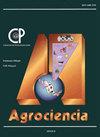MORPHOLOGICAL CHARACTERIZATION OF NATIVE MAIZE POPULATIONS OF THE RATÓN RACE FROM COAHUILA, MEXICO
IF 0.5
4区 农林科学
Q4 AGRICULTURE, MULTIDISCIPLINARY
引用次数: 0
Abstract
Because of its wide distribution and adaptation, the maize Ratón race (Zea mays L.) is an important component of the diversity in the state of Coahuila, Mexico. The objective of the present research was to perform a morphological characterization of 83 native populations of the Ratón race and identify a subset that will represent diversity. Populations were evaluated in replicated experiments at two different locations with two planting dates per location. Twenty-six quantitative characters of the plant, tassel, ear and grain were recorded, and 14 additional characters (indices) were calculated as relationships among characters. Phenotypic diversity was examined by principal component and cluster analyses. Differences (p ≤ 0.01, p ≤ 0.05) among environments were found for 28 characters and (p ≤ 0.01) among populations for all characters, due to variation in environments and diversity among populations, respectively. Also, differences were found (p ≤ 0.01, p ≤ 0.05) in 38 of the 40 characters in the populations × environments interaction, as a differential response of the populations in the environments. Based on the repeatability index (r > 1.0), 10 characters and nine indices less influenced by the environment were selected for classification. The first two components explained 53.3 % of the total variation and it was established that the vegetative, ear and tassel characters were the most important in describing the variation; this allowed to identify a pattern of diversity associated with the area of adaptation of populations in low - intermediate - transition areas, which reveals that maize variation is closely related to altitude, and temperature and humidity gradients. Based on the dendrogram, a representative subset of the diversity of the Ratón race in Coahuila was obtained, made up of 13 of 83 populations (15.7 %).墨西哥科阿韦拉ratÓn种本土玉米居群的形态特征
由于其广泛的分布和适应性,玉米Ratón种(Zea mays L.)是墨西哥科阿韦拉州多样性的重要组成部分。本研究的目的是对Ratón人种的83个本地种群进行形态学表征,并确定一个代表多样性的子集。在两个不同地点的重复试验中对种群进行了评估,每个地点有两个种植日期。记录了植株、穗子、穗和籽粒的26个数量性状,并计算了14个性状间关系的附加性状(指数)。表型多样性采用主成分分析和聚类分析。环境间差异(p≤0.01)和群体间差异(p≤0.01)分别是环境差异和群体间多样性的结果。40个性状中有38个性状在种群×环境互作中存在差异(p≤0.01,p≤0.05),这是种群对环境的差异响应。根据重复性指数(r > 1.0),选取受环境影响较小的10个性状和9个指标进行分类。前两个成分解释了53.3%的总变异,确定了营养性状、穗性状和穗性状在描述变异中最重要;这使我们能够确定与低-中等过渡地区种群适应面积相关的多样性模式,这表明玉米变异与海拔、温度和湿度梯度密切相关。基于树形图,获得了科阿韦拉Ratón人种多样性的代表性子集,由83个种群中的13个(15.7%)组成。
本文章由计算机程序翻译,如有差异,请以英文原文为准。
求助全文
约1分钟内获得全文
求助全文
来源期刊

Agrociencia
农林科学-农业综合
CiteScore
0.50
自引率
33.30%
发文量
51
审稿时长
18-36 weeks
期刊介绍:
AGROCIENCIA is a scientific journal created and sponsored by the Colegio de Postgraduados. Its main objective is the publication and diffusion of agricultural, animal and forestry sciences research results from mexican and foreign scientists. All contributions are peer reviewed. Starting in the year 2000, AGROCIENCIA became a bimonthly and fully bilingual journal (Spanish and English versions in the same issue). Since 2007 appears every month and a half (eight issues per year). In addition to the printed issues, the full content is available in electronic format.
 求助内容:
求助内容: 应助结果提醒方式:
应助结果提醒方式:


